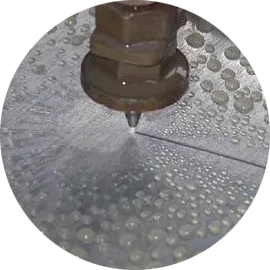Time to read: 6 min

Abstract: When selecting a cutting technique, the choice between abrasive and pure waterjet cutting may arise. Both methods utilize high-pressure water but differ in their approach and application. This article compares the two to guide you in selecting the optimal cutting method for your specific project requirements.
Body:
Material cutting can be effectively performed using waterjet technology, which comes in two primary forms: abrasive and pure. Each method has its unique advantages and ideal applications, making the choice between them contingent on various project-specific factors.
Abrasive Waterjet Cutting
Abrasive waterjet cutting employs diamond abrasives mixed with high-pressure water to cut through an array of materials, including metals, plastics, and composites. The abrasive particles enhance the water's cutting ability, allowing for deeper penetration and increased wear resistance on tooling and components.
Pure Waterjet Cutting
A more recent innovation, pure waterjet cutting, foregoes abrasive materials and relies solely on pressurized water. This method generates less heat, making it suitable for sensitive materials that could be damaged by the heat generated in abrasive cutting.
Differences Between Abrasive vs. Pure Waterjet Cutting
Process
- Abrasive waterjet cutting incorporates sand or garnet grit, creating high temperatures and pressures that facilitate cutting through a wide range of materials.
- Pure waterjet cutting operates without abrasives, using the force and pressure of the water stream to cut materials without affecting their surface finish or integrity.
Materials
- Abrasive waterjets can cut various materials, but require grinding before use to prevent damage.
- Pure waterjets may not be compatible with all materials, necessitating a check for material compatibility.
Precision
- Abrasive waterjet cutting achieves high precision with a sharp, high-speed steel wire, suitable for hard materials like stainless steel and titanium.
- Pure waterjet cutting's precision comes from a fine, high-pressure water beam focused by a lens, allowing for intricate cuts without damaging the surrounding area.
Application
- Abrasive waterjet cutting is prevalent in industries like metal and sheet metal fabrication.
- Pure waterjet cutting finds applications in stone cutting, concrete cutting, and glass etching.
Operation Costs
- Abrasive waterjets require periodic replenishment of abrasive particles, incurring additional costs over time.
- Pure waterjet cutting uses tap water, eliminating the need for consumables or replacement parts, thus reducing operational costs.
Advantages and Disadvantages
Abrasive Waterjet Cutting
- Advantages: Ability to cut hard materials, faster cutting speeds, greater precision, cost-effective for industrial projects.
- Disadvantages: More expensive than pure waterjet, increased wear and tear on equipment, potential health and environmental concerns.
Pure Waterjet Cutting
- Advantages: Cheaper alternative, cold cutting process, high precision, ease of use.
- Disadvantages: Slower cutting speed, limited to soft materials, may not be feasible for hard materials.
Conclusion
The choice between abrasive and pure waterjet cutting rests on evaluating their respective pros and cons in relation to your project's needs. Factors such as material type, precision requirements, and cost considerations will guide your decision.
UnoFactory offers on-demand waterjet cutting services tailored to your manufacturing needs, ensuring precision cutting with rapid turnaround times. Our services cater to both prototyping and high-volume production, delivering the best results with minimal hassle.




